This article is from the May 10, 1999 edition of the Star Tribune and is used by permission. Original graphic and photos by the Star Tribune. Additional photos of Allan Lee, John Mercado, Ted Fahey and Jim Griffin were added for this web page. Also added is an audio account of this incident made by Ted Fahey on November 29, 2007.
Half-century hasn't blurred memories of officer's death
Each May Minnesota police officers remember colleagues who died in the line of duty. Here's the story of one St. Paul cop.
By Curt Brown
Star Tribune Staff Writer
Each May, Minnesota police officers pause to remember colleagues who died on the job.
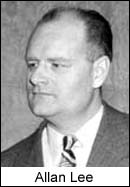 And
when members of the St. Paul Police Department gather later this
week to conduct a mock roll call, Allan George Lee will be among
the 29 names of St. Paul officers killed on duty. The bighearted
detective was gunned down nearly 50 years ago by a liquor store bandit
in St Paul’s old Rondo neighborhood.
And
when members of the St. Paul Police Department gather later this
week to conduct a mock roll call, Allan George Lee will be among
the 29 names of St. Paul officers killed on duty. The bighearted
detective was gunned down nearly 50 years ago by a liquor store bandit
in St Paul’s old Rondo neighborhood.
For a group of retired officers and the son Lee left behind, the half-century hasn't dimmed the memories or dulled the pain. Lee’s story is a poignant reminder of how the death of a cop can defy time and resonate so deeply for those left in its wake.
Jim Lee was just starting fifth grade on Sept. 10, 1949 when a reporter knocked on his door at dusk, asking for a picture of his dad.
Now 59 and a business executive who lives in Roseville, Lee recently sat down with three cops who worked beside his father up until that last day.
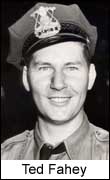 Ted
Fahey, 78, told the kid-no-more he has always felt responsible for
Lee’s death. Fahey and his partner shot at Lee’s
killer but missed, setting off a six-hour hunt. (Listen
to Ted Fahey as he remembers this incident in 2007)
Ted
Fahey, 78, told the kid-no-more he has always felt responsible for
Lee’s death. Fahey and his partner shot at Lee’s
killer but missed, setting off a six-hour hunt. (Listen
to Ted Fahey as he remembers this incident in 2007)
Jim Griffin, 81, enjoyed plenty of memorable days in his 42 years on the St. Paul police force, including becoming the first black sergeant, captain and deputy chief. A longtime referee and former member of the St. Paul school board, his name adorns the football field at his alma mater, St. Paul Central High School.
But he remembers Sept. 10, 1949, as vividly as any day. It was the only time he ever fired his weapon at someone, helping end the standoff in a Rondo Avenue apartment, near where Interstate Hwy. 94 now slices through the city west of the State Capitol.
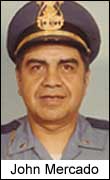 John Mercado, now 77, was just a rookie cop, but played a key role
in uncovering the suspect’s hiding place.
John Mercado, now 77, was just a rookie cop, but played a key role
in uncovering the suspect’s hiding place.
And Jim Lee recalled: “I don’t remember much from when I was 10. But I sure remember that day.”
Shots exchanged
Most of those involved in the drama were in the early stages of their police careers. Some weren't even on duly when the call went out to help corral the suspected thief who had already fired at two cops.
Mercado was taking advantage of a rare day off to celebrate his wife’s birthday. Griffin was off, too, enjoying a movie downtown.
Fahey and his partner, Richard Rowan, who would become chief 21 years later, were working the 4 p.m.-to-midnight shift.
At Janssen's Liquor Store at 365 W. University Av., clerk John DeZelar was alone when Oliver Crutcher, 30, walked in at about 4:10 p.m. The customer handed him $2 for a half-pint of whiskey, then stuck a gun in his ribs and cleaned out the cash register.
Fahey and Rowan were just driving by.
“Then we hear a woman hollering, ‘Stop that man! He just robbed someone…,’” Fahey remembered.
Rowan, an expert shot on the target range, pulled a 6-inch gun out of his left holster. Rowan told Crutcher to get his hands up.
“We could see some money sticking out of the pocket of what looked like a World War II field jacket,” Fahey said. “But when he pulls his hand out, he’s got a gun.”
The officers and the robber exchanged shots, but no one was hit and Crutcher ran toward Rondo Avenue.
Quiet, careful cop
Allan Lee, 42, had been on the force for a dozen years. Unlike many officers of the era, Lee had a college education; he had graduated from Bethel College and the University of Minnesota.
His friends said he seldom swore, smoked or drank. And unlike many of the younger cowboys just back from serving in the military during World War II, Lee was quiet, religious and careful.
“Earlier that summer we were on a domestic call when a father-in-law had kicked his son-in-law out of the house,” Fahey said. “Well, the son went and got his deer rifle and was coming back when I chased him into a garage.”
Lee scolded the young officer.
“He told me I was a darn fool and I could have gotten myself killed,” Fahey said. “He was always the teacher, instructing me how to protect myself.”
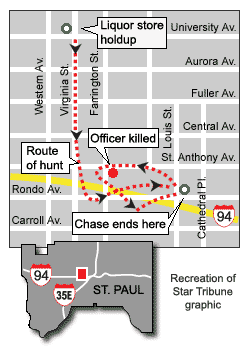 |
Tracking a cop killer Fifty years ago, St. Paul detective Allan Lee was slain during a six-hour hunt for a man who held up a liquor store. This 1949 map shows where the chase took place in the city's Rondo neighborhood, much of which has been replaced by Interstate 94. |
A blinding flash
By 7p.m., the hunt for Crutcher had attracted a crowd. Newspaper photographers, hundreds of onlookers and more than 50 police officers had swarmed into Rondo.
Officers had surrounded a house at 324 St. Anthony Av., acting on a tip that Crutcher was hiding in the basement.
Lee was on the front porch with a shotgun when a St. Paul Pioneer Press photographer named Hi Paul told him that other officers wanted him to see whether there was a basement window in the front of the house.
“I found Lee and stayed to talk with him,” Paul wrote in that Sunday’s St. Paul newspaper. “Since he did not want to leave his post, he asked me if I would take a look. I walked about 10 feet to the edge of the porch and was just bending over to look, when I heard a bang and saw a blinding flash from the corner of my eye."
“Crutcher was sneaking down the front stairs into the front room of the house,” Fahey said. “Allan Lee was in the front doorway when he was shot twice—once in the forehead and once in the abdomen.”
Fahey thinks Lee probably died instantly, although the police report said he died shortly after arriving at a hospital.
Crutcher, meanwhile, jumped over Lee’s body and escaped. Again.
Call home
At Lee’s house on Merrill Street on the city’s North End, his wife, Geneva, and his children Jim and 4-year-old Karen, were surprised when a Minneapolis reporter knocked on the door and asked for a current photo of Allan Lee.
“Somehow in the rush of it all, we hadn't been notified.” Jim Lee said. “My mother said ‘no’ to the reporter and got worried.”
She called headquarters and asked if they could have detective Lee please call home.
“A very nervous voice on the other end didn't know what to say, but stammered out with a ‘Yes, we'll have him call,’” Jim Lee said. “My mother kept saying, ‘This doesn't sound right.’ About 10 minutes later, one of my dad’s friends called.”
Scared to death
By 10 p.m., police had surrounded a two-story building at 227 Rondo Av. They fired tear gas into a bedroom.
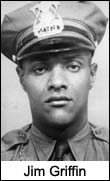 Griffin
joined the siege on his way from the movie theater to his home
at 587 Rondo Av. Mercado had been called to work from his wife’s
birthday party.
Griffin
joined the siege on his way from the movie theater to his home
at 587 Rondo Av. Mercado had been called to work from his wife’s
birthday party.
“They had two gas masks and asked for volunteers,” Griffin recalled.
Vernon (Boots) Michels, a popular cop known for his two-fisted drinking and motorcycle riding, raised his hand. So did Griffin.
“Don’t ask me why,” Griffin says now. “After I started up the stairs, I said to myself I was probably the biggest damn fool in history. I was scared to death and could hardly breathe.”
Following Griffin up the stairs and into the bedroom, Mercado reached to tear down a curtain so police officers on a neighboring roof could see into the bedroom, but he slipped and fell to the floor.
“And as I looked underneath the bed, I could see an elbow sticking out and the mattress swayed down covering the fellow we were looking for,” Mercado said. “I stood up and said, ‘There he is.’ And that was the end. Jim and Michels were there and others came rushing in and started shooting, and I could just hear the bullets whizzing by me.”
Crutcher hadn't said a word or gotten off a shot. The coroner said he was shot a dozen times.
“I think I got off a couple shots, but I don’t think I hit him,” Griffin said. “In those days, we weren't trained for these types of situations and they didn't do autopsies to see which bullets came from which guns.”
Epilogue
Three years after Lee was buried in Roselawn Cemetery just north of the city limits and Crutcher was buried near his mother’s home in Taylorsville, Ky., Jim Lee was goofing around with some teenage friends in an alley near Como Park.
“We were throwing firecrackers when Mr. Griffin came around in his squad car,” Lee said. “He got us aside told us to quit doing that and he was actually pretty nice about it. Then he asked my name. I said James Lee. He looked me in the eye and said, ‘Are you Allan Lee’s son?’
“I'll never forget that day because I was so ashamed,” Jim Lee said. “Here I had besmirched my father’s good name and Mr. Griffin just kind of shook his head.”
Jim Lee went on to graduate from the University of Minnesota in 1962 and has become a successful businessman. He served as one of Carl Pohlad's chief accountants for 20 years before becoming the chief financial officer for the Soo Line Railroad. Currently, he is a senior vice president of finance for the Canadian Pacific Railway’s U.S. operations.
His sister, Karen, is a school teacher in Minneapolis and has three grown children.
Jim and his wife, Linda, have been married for 37 years and have two children. They also have a grandson, 14-month-old Allan Lee; named for the great-grandfather he never met.
In the Rondo neighborhood, most of the buildings, front porches, alleys and streets where the shootout took place were removed for the construction of Interstate Hwy. 94 in the 1960s. The liquor store is now the home of the Vang Dental Clinic on University Avenue.
After her husband’s death, Geneva Lee worked as a secretary in downtown St. Paul and helped put Jim and Karen through college. She died in 1989.
The family received a pension check, adjusted for inflation, that rose to about $800 a month by the time Geneva died. Under current state law, the dependents of an officer slain today would be entitled to a lump-sum payment of $100,000 from the state.
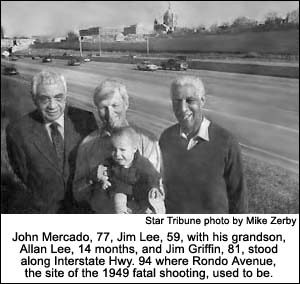 A
wish granted
A
wish granted
Jim Lee had a lingering need to know more of his father’s story.
“I'm proud of my dad,” he said. “But I'm curious to learn the things I was sheltered from at the time.”
In the recent meeting with Griffin, Mercado and Fahey, he finally got his wish.
Griffin told him his father “wasn't the type to go grousing about this or that, in fact, I never heard the man use a curse word and I never heard anyone say a bad word about him. He was just a really nice fellow.”
And Fahey told him, “Dick Rowan and I always felt responsible for your dad’s death. If the guy hadn't gotten away from us…”
Jim Lee interrupted. “You did your best,” he said. “You can’t second-guess yourself now.”
